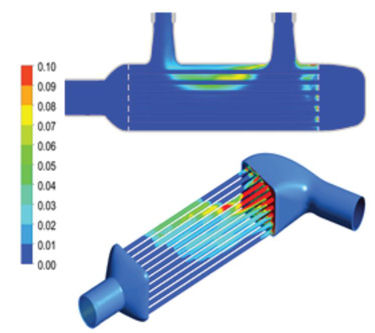Designing a High-Quality Exhaust Gas Recirculation Cooler with CFD
Latest News
October 27, 2014
 Dear Desktop Engineering Reader:
Dear Desktop Engineering Reader:
To help comply with Environmental Protection Agency (EPA) and state emissions standards, your car has some sort of exhaust gas recirculation (EGR) system. EGR systems play a key role in reducing environmentally harmful NOx (nitrogen oxide) emissions from automotive engines. When it’s working right, your engine runs efficiently and you think nothing of it. But if it fails, your best-case scenario is that your check engine light comes on and you’re out a bunch of money. The worst case could have coolant squirting directly into your engine and ruining it.
Today’s Check it Out link takes you to an ANSYS Tech Tip on simulating EGR systems called “Designing High-Quality Exhaust Gas Recirculation Cooler with CFD – Simulating Wall Boiling.” It matters not if EGRs are in your wheelhouse. This is interesting stuff.
This ANSYS Tech Tip has two components. The first is a step-by-step video demo of using ANSYS CFD (computational fluid dynamics) software technology, ANSYS Fluent, to predict the performance and reliability of an EGR cooler. The second is a technical white paper that delves deeper into the video’s subject matter. Together, the two provide a first-rate explanation of the tools available from ANSYS for simulating EGR systems, how to go about running the job and the results you can achieve.
In simplified terms, an EGR cools hot exhaust gases and helps reduce smog-forming emissions. It works by taking in hot exhaust gas, replacing oxygen with inert burnt gases and then recirculating this mixture back into the combustion chamber through the inlet manifold. You want to replace as much oxygen as possible, because less oxygen means less NOx forms. The problem is that NOx formation grows exponentially with temperatures, so you have to cool the hot exhaust gases before they are re-introduced in the combustion chamber to avoid it. An EGR cooler does this job.
Coolant boiling resulting from the high temperature of the exhaust gas is one of your big challenges when designing the EGR cooler. To ensure that you cool the exhaust gas to desired temperatures and to avoid undue thermal stresses on such components as cooling tubes and the EGR unit casing, it’s important to prevent formation of coolant vapor pockets. This is where today’s Tech Tip comes into the story. It provides a tour of ANSYS’ offerings for executing this complex simulation.
Among these tools are conjugate heat transfer (CHT) capabilities that enable you to simulate heat transfer in fluids and solids simultaneously as well as a mixture multiphase model to simulate both the coolant and coolant vapor if boiling occurs. You can also use a semi-mechanistic wall boiling model to predict where and when coolant in contact with the cooling tubes boils, and an evaporation-condensation model will simulate the phase change between liquid and gas. ANSYS CFD also allows you to export detailed temperature and vapor maps to the ANSYS Mechanical FEA (finite element analysis) tool for structural analysis, which enables you to perform thermal stress and fatigue simulations.
The video is a crisp 4:36 minutes. It steps you through the process of setting up the simulation, executing it and reviewing your results. It has lots of animations to keep your attention.
The three-page white paper provides the technical meat that complements and extends the video. It begins with bullet points that provide the particulars on the EGR cooler physics as well as needed details such as the total mesh count and the types of models used. EGR cooler components are illustrated and operation parameters are provided. The simulation results are thoroughly explained and well illustrated.
“Designing High-Quality Exhaust Gas Recirculation Cooler with CFD – Simulating Wall Boiling” is ANSYS’ newest Tech Tip in the series, which numbers more than a dozen now. It’s also one of the most fascinating. Hit the link and see for yourself.
Thanks, Pal. – Lockwood
Anthony J. Lockwood
Editor at Large, Desktop Engineering
Click here for the “Designing High-Quality Exhaust Gas Recirculation Cooler with CFD” Tech Tip.
Subscribe to our FREE magazine, FREE email newsletters or both!
Latest News
About the Author
Anthony J. Lockwood is Digital Engineering’s founding editor. He is now retired. Contact him via [email protected].
Follow DE






